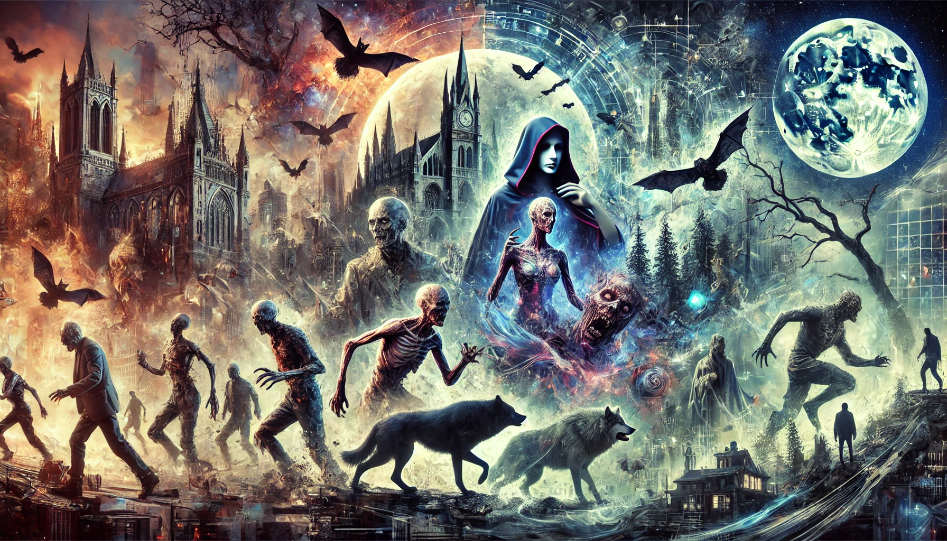Recurring Mythical and Creative Characters in Literature: Zombies, Vampires, Werewolves, and Beyond
-
Richard Pen
| Monday 29th of July 2024 09:26:40 AM (UTC)

In the vast world of literature, certain mythical and creative characters have captured the imagination of readers for centuries. Zombies, vampires, and werewolves are among the most popular, often reappearing in various forms across genres and cultures. These characters not only offer thrilling narratives but also explore deeper themes of humanity, mortality, and the supernatural. Let's delve into these fascinating beings and explore how modern AI, like ChatGPT, can contribute to their ongoing evolution.
Zombies: The Undead Horde
Zombies, typically depicted as reanimated corpses driven by an insatiable hunger for human flesh, have a rich history that dates back to Haitian folklore. The concept of the zombie was popularized in Western culture through films like "Night of the Living Dead" by George A. Romero. In literature, zombies often symbolize societal fears, whether it's the loss of individuality, the spread of disease, or the breakdown of social order.
Key Themes:
- Survival: Stories often focus on small groups of humans trying to survive in a post-apocalyptic world.
- Transformation: The process of becoming a zombie is frequently explored, representing a loss of humanity.
- Societal Collapse: Zombie outbreaks often lead to the fall of civilization, highlighting human fragility.
Vampires: The Eternal Night Dwellers
Vampires, immortal beings who sustain themselves on the blood of the living, have been a staple of literature since Bram Stoker's "Dracula." They embody themes of immortality, forbidden desires, and the duality of human nature. Modern interpretations, like Anne Rice's "The Vampire Chronicles" and Stephenie Meyer's "Twilight" series, have expanded the vampire mythos, exploring their complex relationships and moral dilemmas. For a contemporary take on vampire stories, check out Eternal Dusk: A Thrilling Vampire Tale.
Key Themes:
- Immortality: The curse and blessing of eternal life is a central theme.
- Seduction: Vampires often use their allure to manipulate humans.
- Moral Ambiguity: Vampires can be both villains and tragic heroes, struggling with their nature.
Werewolves: The Cursed Shapeshifters
Werewolves, humans cursed to transform into wolves or wolf-like creatures under the full moon, trace their origins to ancient mythology. In literature, werewolves often represent the primal side of humanity, the struggle between civilization and wild instincts. Stories like those in the "Harry Potter" series and the "Twilight" saga feature werewolves as both fearsome monsters and sympathetic characters. For an engaging werewolf narrative, read Moonlit Rebellion: A Captivating Werewolf Tale.
Key Themes:
- Transformation: The physical and psychological changes during transformation are central to werewolf stories.
- Duality: Werewolves embody the conflict between human intellect and animal instinct.
- Community: Werewolf packs often highlight themes of loyalty and social dynamics.
ChatGPT’s Contribution: New Mythical Characters
As artificial intelligence continues to evolve, so does its role in creative writing. ChatGPT, developed by OpenAI, offers a unique tool for authors to generate fresh and imaginative characters, expanding beyond traditional mythical creatures. AI can help writers create entire worlds filled with original beings, blending classic elements with innovative twists.
Examples of AI-Generated Mythical Characters:
- Ethereal Guardians: Beings made of pure energy, capable of traversing dimensions to protect the balance of the universe.
- Sentient Shadows: Shadows that gain consciousness and can manipulate light and darkness, serving as both protectors and adversaries.
- Time Weavers: Entities that can manipulate time, weaving through past, present, and future to alter destinies and prevent cataclysms.
Key Themes in AI-Created Characters:
- Innovation: AI can generate unique attributes and abilities, leading to fresh narrative possibilities.
- Blending Genres: Combining elements of fantasy, science fiction, and horror to create multifaceted characters.
- Exploring Humanity: Using mythical beings to explore philosophical and existential questions in new ways.
Conclusion
Mythical and creative characters like zombies, vampires, and werewolves continue to captivate readers with their rich histories and complex themes. With the advent of AI like ChatGPT, the literary world is poised to see an infusion of innovative characters and stories, blending the timeless appeal of classic myths with the limitless potential of modern technology. As we look to the future, these new characters will undoubtedly enrich the tapestry of literature, offering fresh perspectives and endless possibilities for storytelling.
By exploring traditional and modern narratives, authors and readers alike can enjoy a diverse and dynamic literary landscape, where the imagination knows no bounds.
Start the conversation
Become a member of TxtTale to start commenting.
Already a member?
